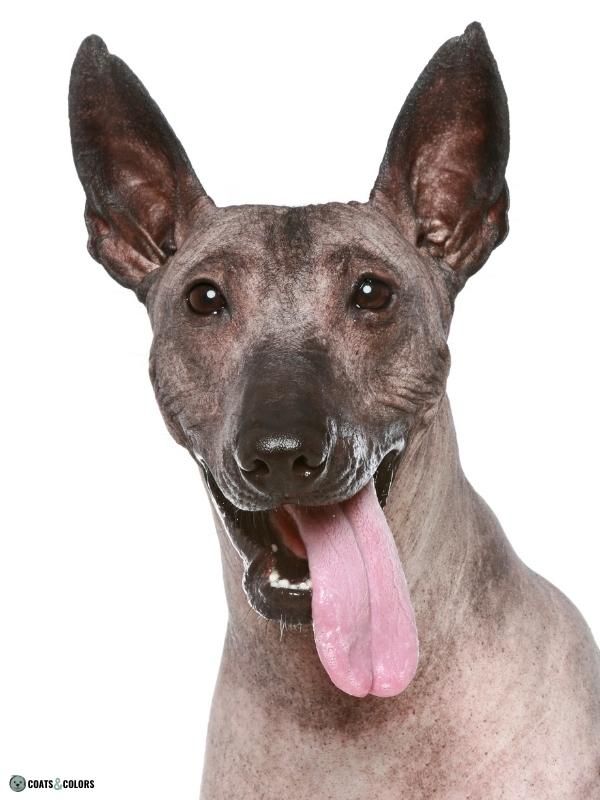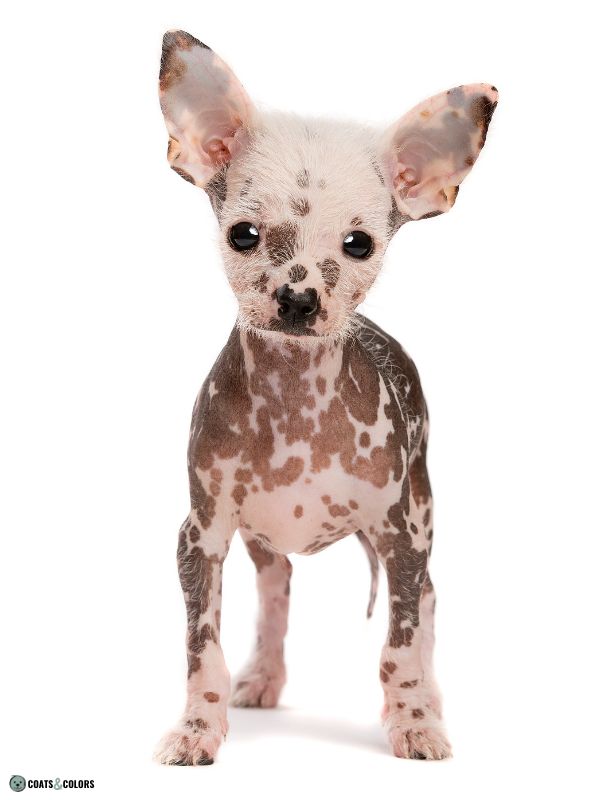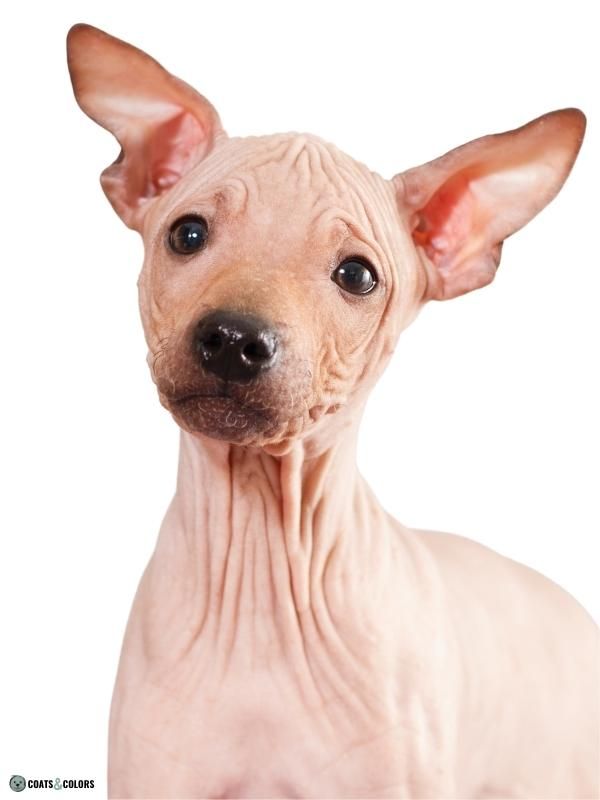The absence of fur is a desired trait in some dog breeds such as the Chinese Crested Dog, Peruvian Hairless Dog, and Xoloitzcuintl. Most hairless dogs lose their fur due to a different mutation (FOXI3) than the more recently developed American Hairless Terrier (SGK3).
Hairlessness: Xolo-Type
This dominant type of hairlessness is found in the Chinese Crested Dog, Peruvian Hairless Dog, Xoloitzcuintli and related breeds. These are old breeds that probably share a common ancestor[1].

Although the Chinese Crested Dog is believed to maybe have an Asian or African origin, the modern Crested probably shares a common ancestor with the Mexican Chihuahua[6].
Compared to a coated dog, these hairless breds only have very simple primary hair follicle.
All of these hairless dogs can show varying degrees of hairlessness up to fully naked. Depending on the breed, they might keep some tufts of hair on the legs, head or tail[3].

The Hr-Locus (Xolo-Type)
Xolo-type hairlessness is caused by a mutation in the FOXI3 gene (forkhead box transcription factor I3) on dog chromosome 17.
FOXI3 is a transcription factor that regulates the development of ectodermal appendages such as hair follicles, teeth, and different glands. This gene is important to embryonic development and is expressed in hair follicles or dental epithelium[4].
So, what happens in hairless dogs?
The mutation at the Hr-Locus responsible for the Xolo-type of hairlessness causes a loss of most of the normal protein. And the resulting FOXI3 deficiency interferes with the development of hair follicles.

Unfortunately, too little FOXI3 is also associated with defects in teeth, brittle toenails as well as malformations of the ear or sweat glands. Newborn hairless puppies may even have a smaller chance to survive compared to their normal littermates[1,3].
This type of hairlessness is categorized as Canine Ectodermal Dysplasia (CED).
Affected dogs not only have problems with post-natal hair growth and hair regeneration but also with dentition (missing teeth, abnormal teeth). At least, other defects seem to be less common[1,3].

The mutant variant Hr at the Hr-Locus is an autosomal semi-dominant trait[4]. One copy of this mutation (Hr/hrc) is enough to cause a hairless phenotype while a homozygous dominant genotype (Hr/Hr) is embryonic lethal.
Dogs with two wild-type alleles (hrc/hrc) have a normal coat.
This is a dominant trait. It will be expressed in every puppy that inherits one copy.
So hairless Chinese Crested Dogs, Xolos, or Peruvian Hairless Dogs have a 50 % chance to pass on their hairless variant to each of their puppies, even in mixed breed litters.
And these mixes can look quite interesting…

FOXI3 Hairlessness Calculator
Hairless dogs with a mutation in the FOXI3 gene are always heterozygous (Hr/hrc). With only one copy of the FOXI3 hairless mutation, these dogs can always produce hairless or fully coated offspring in the same litter.
Breeding from two hairless dogs may result in a reduced litter size since each potential puppy has a 25% chance to have an embryonic lethal Hr/Hr genotype.
Chinese Crested Dogs
Chinese Crested Dogs can be completely hairless or semi-coated with a hairless torso and silky tufts of hair on the head, legs, and tail.
There are some intermediate coat types with some hair mainly on the top of the head. There might be some unknown modifier genes that can affect the expression of this trait.



The coated variety of Chinese Crested Dogs is known as Powder Puff. These dogs have normal compound hair follicles identical to those in coated dog breeds[5].
Chinese Crested Dogs are a longhaired breed. Interestingly, they are also bearded and can even be curly.
| Long | Curly | Wire | FOXI3 |
| ✓ | ✗✓ | ✓ | ✗✓ |
Peruvian Hairless Dog
The Peruvian Hairless Dog and the related Peruvian Inca Orchid have a hairless torso and can have some short hairs on the head, feet and tail.


Since this breed seems to be genetically shorthaired and non-bearded, they never grow the longer or wavy tufts of hair seen in crested dogs.
| Long | Curly | Wire | FOXI3 |
| ✗ | ✗ | ✗ | ✗✓ |
Mexican Hairless Dog
The Xoloitzcuintli or Mexican Hairless Dog most commonly has only short hair on its head, feet, and tail.
The coated variety looks like a typical primitive village dog with pricked ears and a short coat.


During breed formation, different kinds of dogs were used to save this rare breed from extinction.
There might have been many outcross breedings to longhaired or even curly breeds. So it’s not totally unheard of that some coated Xolos are born with a bearded, long, or curly phenotype!
| Long | Curly | Wire | FOXI3 |
| ✗✓ | ✗✓ | ✗✓ | ✗✓ |
Hairlessness: Terrier-Type
Around 1972, a breeder in the US began to breed a hairless variety of the Rat Terrier. This project started after a hairless but otherwise healthy puppy was born in one of her Rat Terrier litters.
American Hairless puppies are born with a tennis ball-like fuzz. However, they lose all of their coat during the first few weeks after birth. This is classified as some kind of hypotrichosis or juvenile alopecia but it is not associated with any health issues or poor teeth quality.


This type of hairlessness is caused by a relatively new mutation only found in the American Hairless Terrier. In 2016, these dogs were recognized as a distinct new breed by the American Kennel Club.
The hr-Locus (Terrier-type)
The hairlessness in American Hairless Terriers s caused by a mutation in the SGK3 gene (serum/glucocorticoid regulated kinase family member 3) on dog chromosome 29[1].
Interestingly, Scottish Deerhound can also produce hairless dogs from coated parents. They have yet another recessive mutation in the SGK3 gene that causes juvenile early-onset hair loss[2,7].
SGK3 seems to be important for the development or maintenance of hair follicles after birth. American Hairless Terriers are born with a little bit of coat but then lose it all permanently.
Hairlessness in the AHT is an autosomal recessive trait. Even one copy of the dominant wild-type Hrc produces a normal coat, a dog needs two copies to be hairless (hr/hr).
SGK3 Hairlessness Calculator
The hairlessness in the American Hairless Terrier is caused by a homozygous recessive genotype (hr/hr). Unlike the hairlessness in Xolos, this is not an embryonic lethal trait.
Coated dogs can carry this recessive trait (Hrc/hr) and produce hairless offspring with other carriers or affected dogs. This sometimes happens in mixed breeds dogs when both parents have American Hairless Terriers in their ancestry.
American Hairless Terrier
American Hairless Terriers are born with a very sparse and thin puppy coat that is commonly lost during the first few months of life. The dogs are otherwise healthy and don’t suffer any health issues associated with the dominant Xolo-type of hairlessness.

So for, the American Hairless Terrier is the only dog breed with this version of recessive hairlessness[1].
The AHT emerged from the Rat Terrier which goes back to multi-terrier crosses and feists but also to Beagle, Miniature Pinscher or Italian Greyhound. If coated AHT are born, they are usually shorthaired.
| Long | Curly | Wire | SGK3 |
| ✗ | ✗ | ✗ | ✓ |
Hairless Dog Breeds
The American Hairless Terrier has a special status among the hairless breeds since these dogs have their very own type of hairlessness.
But most of the hairless dog breeds we know today seem to share a common ancestor.
The hairless dogs from South America like Xolo, Peruvian Hairless Dog and surprisingly the Chinese Crested Dog are considered to be old breeds descending from hairless dogs of the Aztecs and Incas. But the officially recognized versions of these hairless breeds were actually only developed rather recently.
There are a handful of related breeds that are very rare like the Cuban Hairless Dog, Argentine Pila Dog, the Bolivian Hairless Dog, the Ecuadorian Hairless Dog, and the Hairless Khala also from Argentina.
Others hairless dogs are the Jonangi from eastern coastal areas in India or the African Hairless Dogs that seem to be extinct but were known as Abyssinian Sand Terrier among other names.
Learn More
Links
[1] Parker, H. G., Harris, A., Dreger, D.L., Davis, B.W., & Ostrander, E.A. (2017). The Bald and the Beautiful: Hairlessness in Domestic Dog Breeds. Philosophical Transactions of the Royal Society B, 372(1713). https://doi.org/10.1098/rstb.2015.0488
[2] Heidi G Parker, D Thad Whitaker, Alexander C Harris, Elaine A Ostrander. Whole Genome Analysis of a Single Scottish Deerhound Dog Family Provides Independent Corroboration That a SGK3 Coding Variant Leads to Hairlessness. G3 Genes|Genomes|Genetics, Volume 10, Issue 1, 1 January 2020, Pages 293–297. https://doi.org/10.1534/g3.119.400885
[3] Online Mendelian Inheritance in Animals (OMIA). Sydney School of Veterinary Science, University of Sydney. OMIA 000323-9615 (01/2016): Ectodermal dysplasia in Canis lupus familiaris. https://www.omia.org/OMIA000323/9615/
[4] Drögemüller C, Karlsson EK, Hytönen MK, Perloski M, Dolf G, Sainio K, Lohi H, Lindblad-Toh K, Leeb T. 2008. A mutation in hairless dogs implicates FOXI3 in ectodermal development. Science321, 1462. https://doi.org/10.1126/science.1162525
[5] Wiener, D.J., Gurtner, C., Panakova, L., Mausberg, T.B., Müller, E.J., Drögemüller, C., Leeb, T., Welle, M.M. :
Clinical and histological characterization of hair coat and glandular tissue of Chinese crested dogs. Vet Dermatol 24:274-e62, 2013. https://doi.org/10.1111/vde.12008
[6] Parker, Heidi & Dreger, Dayna & Rimbault, Maud & Davis, Brian & Mullen, Alexandra & Carpintero-Ramirez, Gretchen & Ostrander, Elaine. (2017). Genomic Analyses Reveal the Influence of Geographic Origin, Migration, and Hybridization on Modern Dog Breed Development. Cell Reports. 19. 697-708. https://doi.org/10.1016/j.celrep.2017.03.079
[7] Hytönen, M.K., Lohi, H. A frameshift insertion in SGK3 leads to recessive hairlessness in Scottish Deerhounds: a candidate gene for human alopecia conditions. Hum Genet 138, 535–539 (2019). https://doi.org/10.1007/s00439-019-02005-9
Image Credits
© dpcrestock/yayimages.com
© Eric Isselee/canva.com

Hi! I’m Steffi. I am a biologist and a big time dog nerd. You are curious about coat color genetics? You’ve come to the right place! Read more.







